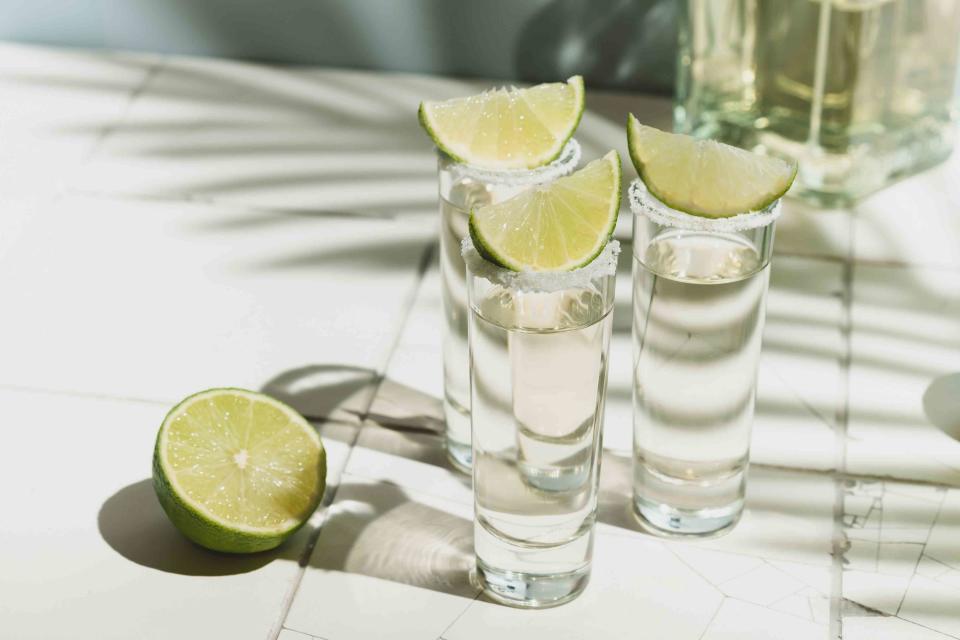What's the Difference Between Añejo and Reposado Tequila?
Understanding the difference between these tequilas is key to making a better margarita.

Goskova Tatiana / Shutterstock
Although a number of tequila designations exist, the most popular three are Blanco, reposado, and Añejo — and the most nuanced differences land between the latter. While all tequila is produced from fermented and distilled agave, their contrasts begin just after the distillation process. While Blanco tequila is released quite young (generally immediately post-distillation to up to two months after), reposado and Añejo tequilas have lengthier aging regimens. Additionally, reposado and Añejo tequila spend time in oak barrels, rendering them more similar to darker spirits (whiskey, dark rum, cognac) than their Blanco counterparts.
A few key things to know: Regardless of designation, all tequila is made from agave across five regions in Mexico, with over 90% of production taking place in Jalisco. To get juice from the agave, local harvesters, known as jimadores, cut the sharp leaves off of the plant and cook their remaining centers, known as piñas. These steamed piñas are then crushed to release their juice, which is fermented in vats prior to distillation and aging.
So what exactly makes a reposado different from an añejo tequila? We enlisted the help of three of Mexico’s top mixologists to break down everything you need to know about these two barrel-aged spirits.
Related:18 Tequila Cocktails Every Home Bartender Should Make
What makes a tequila añejo or reposado?
Gina Barbachano, mixologist at Mexico City-based Hanky Banky, explains that the biggest difference between añejo and reposado tequila is the time they spend in barrel. “Reposado is required to be aged for at least two months, and añejo at least one year,” she says. Gabriela Lozada, bar manager at the all-women run bar, Brujas, elaborates on this, adding that reposado tequila spends more than two months but less than one year in barrel, whereas añejo tequila spends more than one year and less than three years in barrel.
What are the main flavors and aromas in añejo and reposado tequila?
Tito Pin Perez, creative director at Mexico City-based cocktail bar, Rayo, shares that both reposado and añejo tequila vanilla, oak, and spice, though añejo’s flavors will generally be much richer. This can be attributed to the longer time in barrel. (Additionally, Perez cites notes of honey in reposado tequila, whereas añejo will show more cinnamon notes.) “Both are very delicious, but I prefer reposado because it provides flavor but still has punchy tequila notes,” he says.
In addition to vanilla, Barbanchino states that reposado tequila will often show more citrus-forward notes, whereas añejo tequila can often present flavors of dried fruits and cooked agave. In terms of hue, Lozada describes reposado tequila as more pale yellow, whereas añejo tequila will generally show a more amber color in the glass.
Related:Making Tequila Is a True Labor of Love
Is añejo or reposado tequila better for sipping?
Both reposado and añejo tequilas are great for sipping solo (or over a cube of ice) – it’s simply a matter of taste and preference. However, regardless of which style you choose to sip neat, Perez recommends enjoying the tequila at room temperature in a snifter glass, so as to let all of the aromas and flavors come to life.
When would you choose an añejo over a reposado tequila?
While reposado and añejo tequilas are both great for sipping solo and mixing into cocktails, Lozada recommends using reposado for fresher drinks (think variations on brighter classics, such as the French 75), whereas añejos are great for mixing into riffs on more robust drinks, such as a twist on the Old Fashioned.
How to use añejo and reposado tequila in cocktails
Building on Lozada’s tip, Barbanchino recommends using Blanco or Reposado tequila in more citrus-forward drinks, whereas añejo will shine in cocktails made with vermouth, as well as other aged spirits and liqueurs.
“If sipping Reposado or añejo tequila neat, avoid the lime wedge or sangrita, which are traditional pairings for blanco tequila that work very well,” Barbanchino. “Instead, pair them with dark chocolate or a butter toffee, which is exceptional with añejo.” Lozada agrees, stating that dark chocolate “really accentuates the dry notes of the wood” in Reposado tequila. “In the case of the añejo, I discovered an extraordinary complexity by pairing it with peaches, dates, and dried fruits,” she says.
For more Food & Wine news, make sure to sign up for our newsletter!
Read the original article on Food & Wine.

